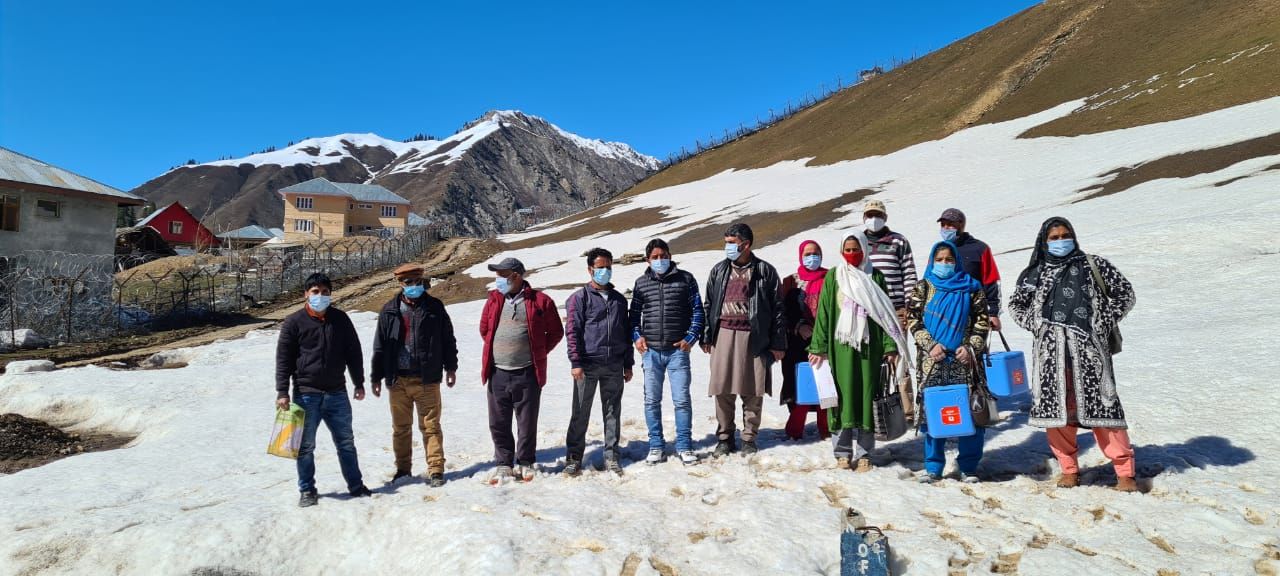
Vaccination drive: How J&K became India's jewel in the crown
In J&K, about 80% of the 45-plus age group has taken the jab, thanks to vaccinators who move mountains to reach more people and fight hesitancy

After facing scathing social media criticism over a poor vaccination drive initially, the administration in the Union Territory (UT) of Jammu and Kashmir is now hogging headlines for a successful vaccination campaign that has almost fully overcome hesitancy among the people.
Government figures say J&K has vaccinated 79.7 per cent of its population in the 45-years-plus category since the drive started in January this year. The UT administration also managed to achieve 100 per cent vaccination in the same age group in four districts — Ganderbal, Jammu, Samba and Shopian.
The data for health workers is also encouraging, as 83. 5 per cent of them have taken the first jab and 49.9 per cent have taken the second jab as well. Also, 86.36 per cent of frontline workers have received the first dose and 59.91, the second jab.
Also read: India’s vaccine hesitancy falls by 7% amid inoculation drive: Survey
However, the vaccination programme continues to remain a daunting challenge for healthcare workers in the 18-45 age group. The government has managed to vaccinate only 10 per cent of this population. The target for this month-end is 30 per cent coverage in this age group.
Initial hesitation
Within the first few weeks of the vaccination drive, rumours started doing the rounds, leading to hesitation among the people to take the jab.
“There were already rumours about vaccination,” said Jaffer Ali, a basic health worker in Kullan Zone of Ganderbal district. “Nobody was ready to go for vaccination. I almost felt like an idiot while convincing them to go for the jab.”
But this discouraging response didn’t push Jaffer to give up. His team walked miles through the hilly terrain to ensure people got vaccinated.
“In March this year, we walked in 3-ft snow in a hilly area of Gagangeer for over three hours to vaccinate people in far-flung areas,” he said.
These days Jaffer treks with his team in search of nomadic Gujjar community members, who travel with their livestock, to ensure they get vaccinated before a third wave hits the region.
In an attempt to convince people to get vaccinated, Jaffer took a video of his 12 family members taking the jab, which he uses in his vaccination campaign. Because of these sustained proactive methods by Jaffer and other vaccinators like him, Ganderbal district has managed to achieve 100 per cent innoculation in the 45-plus age group.
Also read: Fight vaccine hesitancy as contagious disease, UN meeting told
A district immunisation officer from Kashmir Valley says his team has managed more than 90 per cent vaccination in the 45-plus age group in his district, but convincing the younger population is getting tough despite most of them being educated.
“The youth is more aggressive and tends to believe in rumours and conspiracy theories,” he said.
Against all odds
Even though these challenges remain, the administration continues with its outreach. In April this year, vaccines were airlifted to the Gurez area along the Line of Control, around 125 km from Srinagar in north Kashmir, which remains cut off till spring due to a heavy snowfall.
“Since we don’t have many motorable roads, we mostly walked to far-off places in extreme cold,” said Sartaj, a basic health worker from Gurez area of the Bandipora district.
His team travelled more than 10 km a day to implement the vaccination drive in Gurez, where over 95 per cent of the population in the 45-plus age group is covered now.
Brawls, stone-pelting
J&K’s immunisation officer Shahid Hussain has applauded health workers for their heroic work in tough circumstances, especially in tackling vaccine hesitancy.
“The pressure on health workers is immense in Kashmir division…they have faced stone-pelting and handled brawls. But they never gave up and left no stone unturned to change the minds of the people,” he said.
The UT of J&K, as per officials, has around 1,500 vaccination centres and over 6,000 vaccinators running the show.
“Our door-to-door awareness is aided by campaigning through local media,” said Hussain.
For achieving the target of 100 per cent vaccination in all districts, the health workers have even rescheduled their routine working hours. “It is the farming season both in Kashmir and Jammu. Farmers leave their homes early, so our health workers start off as per the routine of the farmers,” said Hussain.
He said J&K has followed and applied all scientific methods for the vaccination drive. “At one point of time there was a shortage of vaccines, but we overcame that,” he said.
“We try to communicate with the recipients in a clear manner at all levels. We micro-plan and micro-manage every bit of this vaccination program,” he said.
National example
J&K’s well-drawn strategy has drawn praise from across the country. The Central government plans to replicate the model in other states and UTs.
A member of NITI Aayog, VK Paul, says J&K is emerging as a role model among entities with large territorial areas in conducting targeted testing, stratified vaccination and providing grassroots medical care.
“Over the last two weeks, the J&K model has assisted the UT administration in bringing down the COVID caseload and related deaths per million population to 894 and 62, respectively,” he said.
“We’d be very happy if the people, as well as the top leadership, acknowledge our efforts,” he added.

